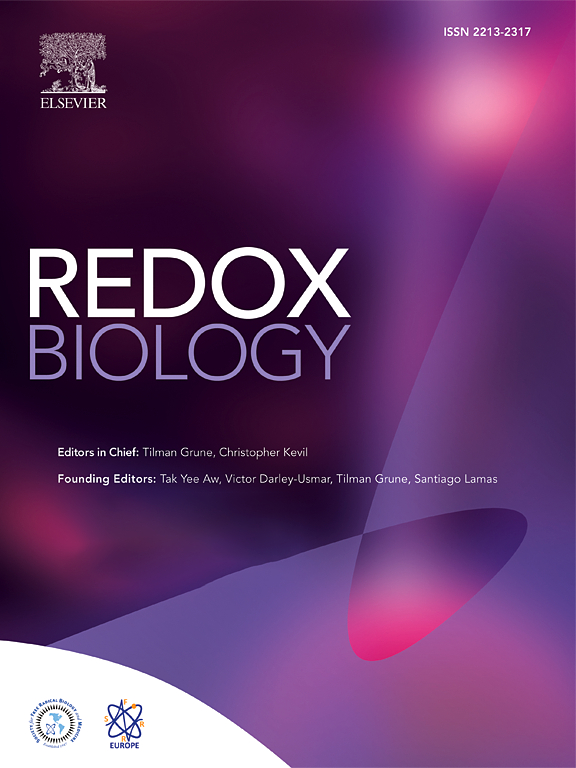Aβ1-42 通过与 TLR4 结合,促进小神经胶质细胞活化和凋亡,从而导致老年痴呆症的发展。
IF 10.7
1区 生物学
Q1 BIOCHEMISTRY & MOLECULAR BIOLOGY
引用次数: 0
摘要
阿尔茨海默病(AD)是最常见的老年性神经退行性疾病之一,也是最具破坏性的老年痴呆症。它的发病机制复杂,目前尚无有效的治疗方法。探索老年痴呆症的发病机制并提供治疗思路能有效改善老年痴呆症的预后。用β淀粉样蛋白1-42(Aβ1-42)培养小胶质细胞,构建AD细胞模型。小胶质细胞被激活后,细胞形态发生变化,炎症因子表达水平升高,细胞凋亡加快,微管相关蛋白(Tau 蛋白)及相关蛋白表达增加。通过上调和下调Toll样受体4(TLR4),将细胞分为TLR4敲除阴性对照组(Lv-NC组)、TLR4敲除组(Lv-TLR4组)、TLR4过表达阴性对照组(Sh-NC组)和TLR4过表达组(Sh-TLR4组)。再次检测炎症因子的表达。结果发现,与 Lv-NC 组相比,Lv-TLR4 组各种炎症因子的表达量减少,细胞凋亡受到抑制,Tau 蛋白及相关蛋白的表达量减少。与 Sh-NC 组相比,Sh-TLR4 组炎症因子的表达增加,细胞凋亡得到促进,Tau 蛋白及相关蛋白的表达增加。这些结果表明,Aβ1-42 可通过与 TLR4 结合促进小胶质细胞活化和凋亡。降低 TLR4 的表达可减少 AD 细胞炎症反应的发生,减缓细胞凋亡。因此,TLR4有望成为预防和治疗AD的新靶点。本文章由计算机程序翻译,如有差异,请以英文原文为准。
Aβ1-42 promotes microglial activation and apoptosis in the progression of AD by binding to TLR4
Alzheimer's disease (AD) is one of the most common age-related neurodegenerative diseases and the most devastating form of senile dementia. It has a complex mechanism and no effective treatment. Exploring the pathogenesis of AD and providing ideas for treatment can effectively improve the prognosis of AD. Microglia were incubated with β-amyloid protein 1-42 (Aβ1-42) to construct an AD cell model. After microglia were activated, cell morphology changed, the expression level of inflammatory factors increased, cell apoptosis was promoted, and the expression of microtubule-associated protein (Tau protein) and related proteins increased. By up-regulating and down-regulating Toll-like receptor 4 (TLR4), the cells were divided into TLR4 knockdown negative control group(Lv-NC group), TLR4 knockdown group(Lv-TLR4 group), TLR4 overexpression negative control group(Sh-NC group), and TLR4 overexpression group(Sh-TLR4 group). The expression of inflammatory factors was detected again. It was found that compared with the Lv-NC group, the expression of various inflammatory factors in the Lv-TLR4 group decreased, cell apoptosis was inhibited, and the expression of Tau protein and related proteins decreased. Compared with the Sh-NC group, the expression of inflammatory factors in the Sh-TLR4 group increased, cell apoptosis was promoted, and the expression of Tau protein and related proteins increased. These results indicate that Aβ1-42 may promote microglial activation and apoptosis by binding to TLR4. Reducing the expression of TLR4 can reduce the occurrence of inflammatory response in AD cells and slow down cell apoptosis. Therefore, TLR4 is expected to become a new target for the prevention and treatment of AD.
求助全文
通过发布文献求助,成功后即可免费获取论文全文。
去求助
来源期刊

Redox Biology
BIOCHEMISTRY & MOLECULAR BIOLOGY-
CiteScore
19.90
自引率
3.50%
发文量
318
审稿时长
25 days
期刊介绍:
Redox Biology is the official journal of the Society for Redox Biology and Medicine and the Society for Free Radical Research-Europe. It is also affiliated with the International Society for Free Radical Research (SFRRI). This journal serves as a platform for publishing pioneering research, innovative methods, and comprehensive review articles in the field of redox biology, encompassing both health and disease.
Redox Biology welcomes various forms of contributions, including research articles (short or full communications), methods, mini-reviews, and commentaries. Through its diverse range of published content, Redox Biology aims to foster advancements and insights in the understanding of redox biology and its implications.
 求助内容:
求助内容: 应助结果提醒方式:
应助结果提醒方式:


